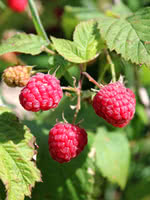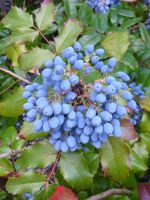Mon-Fri 9am - 5pm Mountain time
Double Delight Raspberry vs Oregon Grape
Rubus x Double Delight
Mahonia aquifolium (Berberis aquifolium)
NOT AVAILABLE THIS SEASON - MIGHT RETURN
NOT AVAILABLE THIS SEASON - MIGHT RETURN
Double Delight raspberries have an excellent sweet-sour flavor. They freeze well and are suitable for use in jams, juices, and pies.
The Double Delight Raspberry is a primocane-fruiting variety, meaning that it produces fruit on first years' growth. Prune stalks down each winter or early spring to get higher fruit yields and easier harvesting.
Oregon Grape is an evergreen shrub native to North America, found along the Pacific coast. In spring, the bright golden-yellow flowers appear in clusters above the leaves. These flowers eventually give way to edible blue berries in late summer. While not a true grape, the berries appear grape-like due to their colouring and clustered growth. They can be eaten fresh, but the sour taste and high amounts of natural pectin make them well suited for preserves.
The Oregon Grape has leaves that are glossy, leathery, and spiny-edged. This feature gives it its alternate name of Holly-leaved Barberry. When the leaves emerge in the spring they are a bronze-red colour. In the summer they transition to green, followed by bright red to deep burgundy in the fall. Leaves are retained throughout the winter and colder temperatures cause the leaves to turn purplish bronze, providing year round interest to the landscape.

